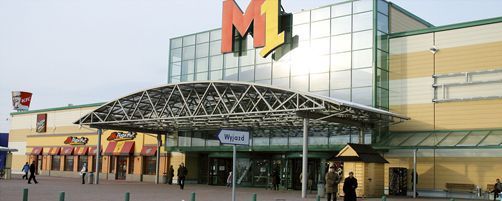Clubbing together
Feature
In early May, a consortium led and managed by Aareal Bank refinanced a loan of EUR 650 mln to Apollo Rida, AREA Property Partners and Axa Group for a portfolio of Metro-affiliate anchored retail properties in Poland. Aareal contributed EUR 250 mln to the club deal, which also involved Helaba and Deutsche Pfandbriefbank (Pbb), who each provided EUR 100 mln, as well as Hypothekenbank Frankfurt, Bank Zachodni WBK and Bank Pekao. News of other refinancing deals has also been slowly, but pleasantly, dripping into our collective consciousness of late. In April Pbb agreed extensions to its EUR 125 mln loan to the Central European Fund managed by Pramerica Real Estate Investors, refinancing three properties across the region: the Trinity Park and A7 Arena office complexes (respectively in Warsaw and Prague) and a retail portfolio in Slovenia. Slovakian developer HB Reavis has recently been another regular beneficiary of refinancing largesse from the banks. This year it has received EUR 64.5 mln for its City Business Center in Bratislava from Erste Bank and an undisclosed lender, and late last year obtained EUR 29 mln in from Slovenská Sporiteľňa bank for the development of Forum Business Center I in the same city.
Sea-change or still in the mire?
Does what we are seeing finally signal a sea-change in the attitudes of banks and financial institutions? Or perhaps the conclusion we should be drawing is that instead of development loans they are still preferring to put their trust in refinancing existing income-producing assets owned by the most established players? According to Mike Atwell, the head of CEE capital markets at CBRE, the financial market is active again, but banks and financial institutions are clearly still being very selective. "In 2013, we have seen increased liquidity, with many of the core German funds and other institutions targeting the prime end of the market. Some of these funds will be buying purely on equity at the acquisition stage but may then finance later. This increased liquidity is good for the Polish market and it is positive to see continued high investment volumes. The key major deals of last year included the Manufaktura and Złote Tarasy shopping centres in Łódź and Warsaw, and I certainly expect to see several major, high volume transactions being completed through 2013. These major investors are tending to dominate the market because of the high profile nature of the deals, but we are also seeing some improvement in the finance markets with a select few banks being open to financing opportunities." When it comes to refinancing, Mike Atwell believes that banks are more keen on providing this particularly after a property is sold, as this allows the banks to restructure the loan onto more secure terms. As evidence for the resuscitation of the financial market, he points to the change in investment figures: "Investment levels in 2009 were very low as a clear result of the European and worldwide crash, but in 2010 we saw a rise in activity, and for both 2011 and 2012 we have seen investment levels in Poland at about EUR 2.7 bln each year," he explains. But the question everyone is asking is what will happen in 2013 and next year. "From my own perspective," says Mr Atwell, "I see a great deal of activity across the retail and office sectors at the prime end of the market and as a result would forecast investment volumes to be at similar levels to last year and maybe possibly higher if all these transactions conclude. I know of deals worth around EUR 1 bln in retail and around EUR 1 bln in offices that are currently in transaction. We often hear talk of the 'Wall of Equity' that is in the European markets, but fortunately for Poland there is allocation to this market. Poland is viewed favourably after the UK, France and Germany as an investment destination but targeted at the prime end of the market.
Spreading the love around
If this is the case, then what types of properties and portfolios are being granted refinancing loans? Dr Walter Hampel, the managing director and head of origination CEE at Pbb Deutsche Pfandbriefbank, claims that the main asset classes being refinanced today are retail properties such as shopping centres, industrial and distribution centres and offices. "Office developments tend to be refinanced on an individual basis, whereas in the retail and logistics sectors it is also portfolios that are receiving such loans. In this region this is occurring mainly in Poland and the Czech Republic. These are the dominant performers in the CEE region," says Dr Hampel. Michał Sternicki, the general manager of Aareal Bank in Poland, stresses that, at least as far as Poland is concerned, on the one hand there is a clear focus from investors on core products with a long term investment horizon, but on the other hand "investors are looking at a variety of product ranges and also their regional attractiveness. For example, the office investment market in relation to core products is still dominated by Warsaw. But retail and logistics properties are enjoying a wider geographical spread and thus attracting both core and opportunistic investors," believes Mr Sternicki. Mike Atwell of CBRE has a more circumspect view of the recent lending activity: "The active banks are being very selective, both in terms of the assets they are willing to lend on and the quality and relationship of the borrower. The banks have historically been very cautious and although this attitude remains, there is still the ability to secure quality finance terms based on a quality asset, in a quality location with a secure, sustainable cash flow. The margins and loan-to-values are naturally different from the days of 2004 to 2008, but at least finance can be obtained," he points out. It is hardly surprising that the terms for such loans are somewhat less comfortable for borrowers than in the days of easy credit, but are the strictures that have been imposed on loans easing at all? "The terms and conditions of refinancing loans are certainly less strict than when compared to the height of the crisis," says Walter Hampel of Pbb, "and this applies not only to the best prime product, but for other good quality properties too. Up to around 50-60 pct debt can be obtained for such assets. This is certainly lower than before the credit crunch, but business is still being done at these terms." Michał Sternicki of Aareal Bank maintains that in Poland the financing conditions being offered by banks are nevertheless well diversified and better conditions can be obtained: "There is a group of lenders which offer parameters in the range of 65 pct loan-to-value, charging higher margins, and another group - mainly German banks - which also exists focusing on loan-to-values in the range of 50-60 pct. However, the general lending conditions depend on various factors, including the property in question," argues Mr Sternicki. Nonetheless, it does seem that this is taking the form of refinancing rather than development loans. "Construction financing is still difficult to come by - and this is especially the case from international, rather than local, financial institutions. But if the owner of an income producing asset wants a new loan where the previous one has expired or wants to refinance a recent purchase, refinancing is available," says Walter Hampel. However, he adds to this that "loans are also available for new projects, but the question in our minds is always: how much product is needed for a location? If our analysis shows that a city is saturated with retail space, then why create more if it is already well-supplied?"
Joining the club
One interesting feature of the large refinancing loans granted since the onset of the financial crisis is that a number of them are now taking the form of rather complicated club deals - consortiums of banks dividing the loan in various ways. The intricacies and advantages of such deals are outlined by Michał Sternicki of Aareal Bank: "A club deal represents a form of syndicated loan whereby all the parties involved are equal lending partners and have equal rights from the first day onwards. This brings a great deal of transparency into the transactions, with the banks benefiting from direct securities as well as participating in the original loan contract. The deal is managed by one syndicate partner who has been approved by all the lenders and who then acts as the agent. The club acts through the latter towards the client who, in turn, has to speak with one voice for the entire consortium. Due to the size of the transaction in question and bearing in mind that a large number of banking partners would require more agency work, the target is clearly to form a banking syndicate with a selected number of professional lenders who could work in an efficient manner and who would be in a position to underwrite large ticket sizes," he explains, pointing out that a further advantage in a club deal is to have an ongoing know-how transfer and exchange of ideas with the other financing parties from the very outset, helping to structure the complexity of the deal in a way that is suitable for all the banks involved. Are club deals, therefore, a trend that will increasingly become the norm in the future? "Club deals are taking place depending on the size of the transaction," explains Walter Hampel. "Most banks are only willing to lend around EUR 100 mln maximum. But before the crisis individual banks were often willing to give out bigger loans. For the Silesia City Center refinancing we were involved in over a year ago, which amounted to more than EUR 200 mln, it was therefore natural for a number of banks to work together to provide this. And the same happened in the recent refinancing of the Apollo Rida portfolio, where the refinancing was for more than EUR 500 mln," he says. The fact that such deals are naturally more complicated and take longer to arrange, doesn't mean that they can't be done, as Dr Hampel points out: "A client looking for refinancing loans will approach a number of banks, and if a few are interested a club deal can take place. I don't think the general terms are much different - it's just that the loan is provided by a number of banks instead of one."
These things take time
The good news for developers and investors is that debt is available, but they must be prepared for more stringent terms, increased equity requirements, and a clear understanding that these transactions will take time. "Transaction times now take a minimum of six months and financing is a big step in that process. The approval process is taking a long time and this is a big lesson from the crisis. We were nowhere near as detailed in examining an asset during the glory years," says Mike Atwell. He regards this change in due diligence as a permanent positive change to the market: "Financing is now available for select assets. What is now important is the quality of the asset, the security and sustainability of the income plus the reputation and relationship that a lender has with its financing partner."
With a contribution from Alex Hayes





















































